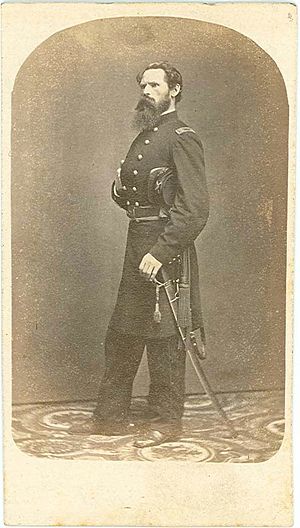Charles J. Stolbrand facts for kids
Quick facts for kids
Charles J. Stolbrand
|
|
|---|---|

Charles J. Stolbrand as major of artillery
|
|
| Birth name | Carl Johan Möller |
| Other name(s) | Carl Johan Ståhlbrand, Carlos J. Stolbrand, Carlos John Mueller Stolbrand (Stohlbrand) |
| Born | May 13, 1821 Össjö parish, Skåne, Sweden |
| Died | February 3, 1894 (aged 72) Charleston, South Carolina |
| Place of burial | |
| Allegiance | Sweden United States |
| Service/ |
Royal Swedish Artillery Union Army, Artillery |
| Years of service | 1839–1850 1861–1866 |
| Rank | Sergeant, Sweden Brigadier General, USV |
| Unit | Royal Wendish Artillery Regiment 2nd Illinois Light Artillery Regiment |
| Commands held | Chief of Artillery, Division, Corps Brigade commander |
| Battles/wars | American Civil War |
| Awards | Knight of the Royal Order of the Sword |
Charles J. Stolbrand (born May 13, 1821 – died February 3, 1894) was a brave soldier and leader. He started as a sergeant in the Swedish army. Later, he moved to the United States and became a high-ranking general in the Union Army during the American Civil War. After the war, he also became an important politician in South Carolina.
Contents
Early Life and Moving to America
Charles Stolbrand was born in Sweden. When he was 18 years old, in 1839, he joined the Royal Wendish Artillery. At this time, he changed his family name to Ståhlbrand.
In 1850, he left the Swedish army. He then moved to the United States with his wife and young son. They first settled in New York City in 1852. Later, they moved to Chicago. There, Stolbrand worked as a land surveyor and a clerk in the Cook County Recorder's Office. He was also active in Chicago's community. He helped start the Svea Society, a group for Swedish-Americans, and was its president for several years.
Serving in the Civil War
When the American Civil War began, Stolbrand wanted to help. He gathered a group of volunteer artillery soldiers. However, his group was not immediately accepted into the army.
Later in 1861, he formed another artillery company. This group became Battery G, 2nd Illinois Light Artillery. Stolbrand became their captain. After only about a month, he was promoted to major.
Key Battles and Promotions
Stolbrand served in the Army of the Tennessee. He was a chief officer for artillery in different parts of the army. He worked under General John A. Logan.
He fought in many important battles, including:
- Battle of Fort Henry
- Battle of Fort Donelson
- Battle of Shiloh
- Siege of Corinth
- Vicksburg Campaign
- Chattanooga Campaign
- Atlanta Campaign
- March to the Sea
- Carolinas Campaign
In September 1864, Stolbrand was captured by the enemy. He became a prisoner of war in Columbia, South Carolina. But he was set free within a month. In 1865, he was promoted to brigadier general. This was a very high rank. It is said that General Sherman himself asked President Lincoln to promote Stolbrand.
Life After the War in South Carolina
After the war ended, Stolbrand moved to Beaufort, South Carolina. He owned a large farm there. He became very involved in Republican politics.
He helped write the state's new constitution in 1868. He also represented South Carolina at a big national meeting for the Republican Party. In the same year, he was chosen to be a presidential elector.
In 1868, Stolbrand was elected to the South Carolina House of Representatives. He left this job in 1869 to become the superintendent of the state prison, the South Carolina Penitentiary. He held this position until 1873.
Later, in 1876, he became the superintendent for building the customs house in Charleston. He worked on this project until it was finished the next year. In 1880, he was given a federal job as a storekeeper. He also ran for Congress but did not win. During President Benjamin Harrison's time in office, Stolbrand was in charge of federal buildings in Charleston.
Family Life
Charles Stolbrand married Maria Sophia Petersson. Her father was also a sergeant-major in the same army regiment as Charles. They had three children in Sweden. After moving to America, they had four more children: three daughters and one son. Their son later served as a lieutenant in the U.S. Army for six years.
In 1894, Stolbrand became sick with the influenza. This led to a serious lung problem, and he passed away. He was buried at Arlington National Cemetery in Arlington, Virginia. His grave is under the name Carlos J. Stolbrand.

